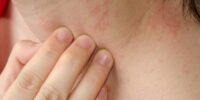Allergies In Children: Common Allergens And Treatment Approaches
Allergies in children are a common health concern that can significantly impact their daily lives. Understanding the various allergens that children may be exposed to is crucial in effectively managing their symptoms and providing appropriate treatment. This article aims to explore the common allergens that affect children and the different treatment approaches available.
By identifying these allergens, parents and caregivers can take necessary precautions to minimize exposure and alleviate symptoms. Allergy testing and diagnosis play a crucial role in identifying the specific triggers, enabling targeted treatment strategies.
Managing allergies in children involves developing an allergy action plan that includes medication, avoidance of allergens, and implementing environmental modifications. Additionally, allergies and asthma often coexist, emphasizing the importance of proper management to prevent severe respiratory complications.
While natural remedies may provide some relief, seeking professional help is essential to ensure accurate diagnosis and appropriate treatment. Lastly, implementing practical tips to allergy-proof the home environment can significantly reduce allergen exposure.
Key Takeaways
- Allergies in children require effective management and treatment.
- Common allergens in children include pollen, dust mites, pet dander, mold spores, certain foods, and insect stings.
- Allergy testing and diagnosis are important for identifying triggers and enabling targeted treatment strategies.
- Managing allergies involves developing an allergy action plan with medication, allergen avoidance, and environmental modifications.
Understanding Allergies in Children
Understanding allergies in children is crucial for parents and medical professionals as it allows for better management and treatment of the condition.
Allergies occur when the immune system reacts abnormally to substances that are harmless to most people. Common allergens in children include pollen, dust mites, pet dander, mold spores, certain foods, and insect stings. These allergens can trigger a range of symptoms, including sneezing, itching, hives, wheezing, and even life-threatening anaphylaxis.
The diagnosis of allergies in children involves a combination of medical history, physical examination, and allergy testing. Once diagnosed, treatment options vary depending on the severity of the allergies. These may include allergen avoidance, medication such as antihistamines or corticosteroids, and allergen immunotherapy.
With proper understanding and management, children with allergies can lead healthy and fulfilling lives.
Identifying Common Allergens
Identifying the prevalent triggers of allergic reactions is a fundamental aspect of comprehending the causes of sensitivities in pediatric patients. By understanding the common allergens, healthcare professionals can better manage and treat allergies in children.
Some of the most prevalent allergens in children include:
-
Pollen: Pollen from trees, grasses, and weeds can trigger allergic rhinitis, commonly known as hay fever.
-
Dust mites: These microscopic insects thrive in warm and humid environments, and their fecal matter can trigger asthma and allergies.
-
Food allergens: Common food allergens in children include milk, eggs, peanuts, tree nuts, soy, wheat, fish, and shellfish.
Identifying these common allergens can help guide allergen avoidance strategies, allergen-specific immunotherapy, and the development of personalized treatment plans to effectively manage allergies in children. It is crucial for healthcare professionals to stay updated on the latest research and advancements in pediatric allergies to provide optimal care for their young patients.
Allergy Testing and Diagnosis
Allergy testing and diagnosis involve the assessment of specific triggers through various methods such as skin prick tests, blood tests, and elimination diets. Skin prick tests are commonly used to identify allergens by applying a small amount of the suspected allergen to the skin and observing for any reactions. Blood tests, such as the specific IgE test, measure the levels of antibodies in the blood that are associated with specific allergens. Elimination diets involve removing suspected allergens from the diet and gradually reintroducing them to identify triggers. These methods help healthcare professionals identify the specific allergens causing symptoms in children, allowing for targeted treatment and management strategies.
The following table provides a summary of the different allergy testing methods:
| Testing Method | Description |
|---|---|
| Skin prick test | Small amounts of suspected allergens are applied to the skin to observe for any allergic reactions. |
| Blood test | Measures the levels of antibodies associated with specific allergens in the blood. |
| Elimination diet | Suspected allergens are removed from the diet and gradually reintroduced to identify triggers. |
Managing Allergies in Children
Managing allergies in pediatric patients requires a comprehensive approach that focuses on minimizing exposure to triggers and implementing appropriate preventive measures. This includes educating both the child and their caregivers about the specific allergens and potential sources of exposure.
An important step in managing allergies is to create an allergen-free environment at home, by removing carpets, using allergy-proof bedding, and regularly cleaning the living space.
Additionally, pharmacotherapy plays a crucial role in managing symptoms. Antihistamines are commonly used to relieve itching and sneezing, while intranasal corticosteroids are effective in reducing nasal congestion and inflammation.
In some cases, allergen immunotherapy may be recommended to desensitize the child’s immune system to specific allergens.
It is important for healthcare providers to work closely with families to develop an individualized management plan that addresses the child’s specific allergies and ensures their overall well-being.
Developing an Allergy Action Plan
One crucial aspect of effectively addressing allergies in pediatric patients involves the development and implementation of a comprehensive allergy action plan. This plan outlines specific steps to be taken in the event of an allergic reaction and ensures that appropriate measures are in place to minimize risk and provide prompt treatment.
The first step in developing an allergy action plan is to identify the common allergens that trigger allergic reactions in children. This may include substances such as pollen, pet dander, dust mites, certain foods, and insect stings.
Once the allergens have been identified, the plan should outline strategies to avoid exposure to these substances, such as modifying the child’s environment or dietary restrictions.
Additionally, the plan should include instructions for recognizing the signs and symptoms of an allergic reaction and the appropriate steps to take, such as administering medication or seeking medical assistance.
Overall, an allergy action plan is an essential tool in managing allergies in children as it provides a systematic approach to prevention and treatment.
Allergies and Asthma
The link between allergies and asthma is well-documented, with studies showing that allergies can trigger asthma symptoms in individuals who already have asthma.
Common allergens such as pollen, dust mites, and pet dander can cause inflammation in the airways, leading to wheezing, coughing, and difficulty breathing.
Managing asthma symptoms in children with allergies involves:
- Identifying and avoiding allergens
- Using medication to control both allergies and asthma
- Developing an individualized asthma action plan in collaboration with healthcare professionals.
The link between allergies and asthma
The relationship between allergies and asthma has been extensively studied, with evidence suggesting a strong link between these two conditions.
It has been observed that individuals with allergies are more likely to develop asthma, and those with asthma often have underlying allergic sensitivities.
Allergic reactions can trigger asthmatic symptoms such as wheezing, coughing, and difficulty breathing.
The mechanism behind this link involves the immune system’s response to allergens. When an allergic individual is exposed to an allergen, the immune system releases chemicals that cause inflammation in the airways, leading to asthma symptoms.
Additionally, allergic inflammation can make the airways more sensitive and reactive to other triggers, further exacerbating asthma symptoms.
Understanding the connection between allergies and asthma is crucial for effective management and treatment approaches for individuals with these conditions.
Managing asthma symptoms in children with allergies
Managing asthma symptoms in children with allergic sensitivities requires a comprehensive understanding of the relationship between allergies and asthma, as well as implementing appropriate strategies for symptom management. Allergies can trigger asthma symptoms in children, leading to increased wheezing, coughing, and shortness of breath. To effectively manage asthma symptoms in children with allergies, a multidisciplinary approach is necessary. This involves identifying and avoiding allergens that may trigger asthma attacks, such as dust mites, pollen, pet dander, or certain foods. Additionally, medications like inhaled corticosteroids and bronchodilators can be prescribed to control inflammation and relax the airways. Regular monitoring of lung function, through techniques like peak flow measurements, can help assess the effectiveness of treatment. By addressing both the underlying allergies and asthma, healthcare professionals can improve the quality of life for children with allergic sensitivities and reduce the frequency and severity of asthma symptoms.
| Allergen | Symptoms | |||
|---|---|---|---|---|
| Dust mites | Coughing, wheezing, sneezing | |||
| Pollen | Runny nose, itchy eyes | |||
| Pet dander | Allergic rhinitis, coughing | |||
| Certain foods | Swelling, hives, difficulty breathing | |||
| Mold | Congestion, itchy skin | Secondhand smoke | Irritated eyes, sore throat |
Natural Remedies for Allergies
This paragraph will discuss natural remedies for allergies, including nasal irrigation, honey for allergies, and probiotics for allergy prevention.
Nasal irrigation, a process of flushing out the nasal passages with a saline solution, has been shown to alleviate symptoms of allergies by removing allergens and reducing inflammation.
Honey, particularly raw and locally sourced, has been suggested as a potential remedy for allergies due to its anti-inflammatory and immune-boosting properties.
Additionally, probiotics, which are beneficial bacteria, have been studied for their potential role in preventing allergies by modulating the immune response and promoting a healthy gut microbiome.
Nasal irrigation
Nasal irrigation is a widely used technique for alleviating symptoms associated with allergies in children. It involves flushing the nasal passages with a saline solution to remove allergens, irritants, and excess mucus.
The process typically involves using a neti pot or a nasal irrigation device to gently pour the solution into one nostril, allowing it to flow out through the other nostril. This helps to moisturize the nasal passages, reduce inflammation, and clear out allergens, providing relief from nasal congestion, sneezing, and itching.
Nasal irrigation has been found to be safe and effective in reducing allergy symptoms in children. It is important to use sterile or distilled water when performing nasal irrigation to prevent the risk of infection. Additionally, it is recommended to consult with a healthcare professional before starting nasal irrigation, especially in children with certain medical conditions or nasal abnormalities.
Honey for allergies
Honey has been explored as a potential remedy for alleviating symptoms associated with allergic reactions. It is believed that the consumption of locally produced honey can help reduce the severity of allergic reactions to pollen. This is due to the presence of small amounts of pollen in honey, which can act as a form of immunotherapy.
However, the scientific evidence supporting the use of honey for allergies is limited and inconclusive. Some studies have shown a small reduction in symptoms, while others have found no significant difference compared to a placebo.
It is important to note that honey should not be given to children under the age of one due to the risk of botulism. Additionally, individuals with severe allergies or asthma should seek medical advice before trying honey as a treatment approach.
Probiotics and allergy prevention
Probiotics have emerged as a potential avenue for preventing the development of allergies, offering hope for individuals seeking effective methods to mitigate the burden of allergic reactions. These live microorganisms, when consumed in adequate amounts, have been shown to modulate the immune system, promoting a more balanced response to allergens.
Here are some key points about probiotics and their role in allergy prevention:
- Probiotics enhance the integrity of the gut barrier, reducing the passage of allergens into the bloodstream.
- They stimulate the production of anti-inflammatory molecules, which can counteract the allergic response.
- Probiotics influence the composition of the gut microbiota, promoting a diverse and healthy microbial community that can regulate immune function.
- They have been found to reduce the risk of eczema and food allergies in infants and young children.
- The beneficial effects of probiotics seem to be strain-specific, emphasizing the importance of choosing the right probiotic product.
Further research is needed to fully understand the mechanisms behind probiotics’ allergy-preventive properties and to optimize their use in clinical practice.
Tips for Allergy-Proofing Your Home
To effectively reduce the risk of allergen exposure at home, it is important to implement proper cleaning routines and maintain a dust-free environment.
Dust mites, pet dander, mold spores, and pollen are common allergens that can trigger allergic reactions in children.
Regularly vacuuming carpets and upholstery, using allergen-proof covers on mattresses and pillows, and washing bedding in hot water can help eliminate dust mites and their feces.
Keeping pets out of the child’s bedroom and using air purifiers can minimize exposure to pet dander.
Reducing moisture levels in the home by using dehumidifiers and addressing any water leaks or mold issues can prevent mold spores from circulating in the air.
Lastly, keeping windows closed during high pollen seasons and using HEPA filters in air conditioning units can reduce pollen exposure.
Seeking Professional Help
Seeking professional help can be beneficial in managing and addressing allergy symptoms effectively. Allergies in children can range from mild to severe and can greatly impact their quality of life. Consulting with a healthcare professional specializing in allergies, such as an allergist or immunologist, can provide valuable insights and guidance.
These professionals are trained to identify common allergens and develop personalized treatment plans based on individual needs. They may conduct allergy tests to determine specific triggers and recommend appropriate medications, such as antihistamines or corticosteroids, to alleviate symptoms. Moreover, they can educate parents on allergen avoidance strategies, such as creating an allergen-free home environment and implementing dietary modifications.
Regular follow-up visits with a healthcare professional can help monitor the child’s progress and adjust treatment plans accordingly. Ultimately, seeking professional help can significantly improve the management and overall well-being of children with allergies.
Frequently Asked Questions
Can allergies in children be outgrown over time?
Yes, allergies in children can be outgrown over time. This process is known as immunological tolerance, where the immune system becomes less reactive to the specific allergen, leading to a reduction or elimination of symptoms.
What are the long-term effects of untreated allergies in children?
Untreated allergies in children may lead to chronic inflammation, impaired quality of life, and increased risk of developing asthma. Long-term effects may include chronic sinusitis, recurrent ear infections, and poor school performance.
Are there any alternative treatments for allergies in children besides medication?
Alternative treatments for allergies in children, aside from medication, include allergen avoidance, immunotherapy, and complementary therapies such as acupuncture. These approaches aim to reduce exposure to allergens and modulate the immune response for symptom relief.
How can parents determine if their child’s symptoms are due to allergies or a common cold?
Determining if a child’s symptoms are due to allergies or a common cold can be challenging. Symptoms such as runny nose and sneezing can occur in both conditions, but allergies may also involve itchy eyes and a more persistent cough.
Are there any specific dietary recommendations for children with allergies?
There are specific dietary recommendations for children with allergies. These recommendations aim to avoid or limit exposure to the allergens and may include eliminating certain foods or following a specialized diet under the guidance of a healthcare professional.








